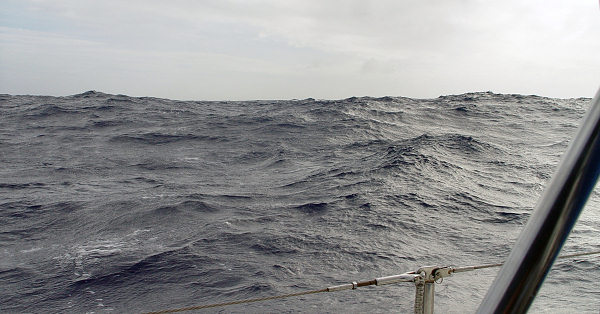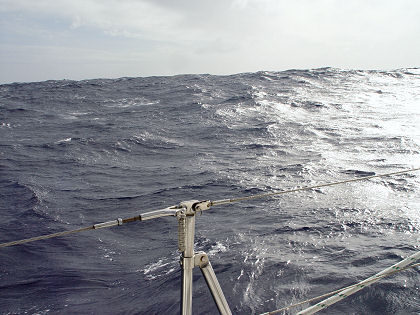
 |
|
| More wave pictures. |
Wednesday, June 2, 2004 (continued)
On my night watch last night there was another boat problem. The batteries were low enough to require recharging, so as usual, I started the engine. It started a little funny though, and I noticed the tach didn't indicate any RPM's even though the engine was definitely running. I know most tachometers run off a special alternator signal, so I went below to see if the alternator was putting out any amps. No joy, the energy monitor registered zero amps.
I considered this to be a serious problem, so I woke David and described the symptoms. We both went up to the cockpit and looked at the engine control panel. The lights were dim and working poorly. David opened an access panel, reached behind the control panel, and started wiggling wires. All of a sudden, all the control panel lights went out. We discovered that the "Stop" push-button didn't work either, so the engine kept running.
David got some tools and removed the engine control panel. We both sat there in the dark cockpit, working by flashlight, as the boat pitched and rolled on the still-sizable seas. While we were probing voltages and attempting to diagnose the problem, all of a sudden the engine mysteriously sputtered to a stop.
Eventually, we found three corroded and loose wires in a connector behind the access panel. David made some temporary crimped connections to bypass the problem. Great! Now the control panel worked perfectly! But we discovered a new problem: the engine wouldn't start. We theorized that without DC power from the control panel, the electric fuel pump stopped and the engine became starved for fuel; after a few minutes it sputtered to a stop. So with problem #1 solved, now problem #2 was to bleed the engine fuel system. This is never fun, especially at night after a very tiring storm, but David performed like a real trouper and had the engine quickly bled (something tells me he's done this before!). With a little coaxing, the engine sputtered to life and ran fine. Problem #2 fixed! (We need a big red stamp that says "Fixed" to stamp in the logbook where we write down all the problems.)
 |
|
| As I mentioned earlier, all the wave pictures are from June 1. |
The rest of the day was tedious. The hand-steering watches get to be a real grind, two hours on, four hours off, 24 hours a day. That means everyone stands four watches a day—mine are at 4:00 a.m., 10:00 a.m., 4:00 p.m., and 10:00 p.m. Another problem is that the winds have worked around to southeast-ish, which is the direction we want to go, so naturally we have to bear away from our desired course to get the sails to draw. The weather has certainly changed since the gale; we now have a high barometer, though it's cloudy. The seas are back to normal.
Later in the day David did more boat repairs, replacing a clogged fuel filter for the engine. Unfortunately, the engine wouldn't start afterwards which caused some consternation. The problem was tough to diagnose and the repair effort wound up consuming hours. Finally, David got tired and put off the rest of the repairs until tomorrow.
Thursday, June 3, 2004 (Day 8 of the Juan Fernández Passage)
David worked on the engine fuel problem again today. Initially, he thought the electric fuel pump had failed so he replaced the fuel pump. But that didn't solve the problem, so the old fuel pump had actually been OK. He eventually decided that somehow the fuel pump had lost its prime, a conceptually simple problem, but it was a difficult and messy job repriming the whole fuel system. David spent hours on it and finally was successful in the afternoon; the engine is now back in-service.
We have been "self-steering" through light to moderate air, all from the wrong direction, under a surprisingly cloudy sky for such a high barometer. The weather became a little murky and we got a fluky wind shift and a period of erratic winds, then we broke out into robust southeast winds under a blue sky flecked with fair-weather cumulus clouds. It also got cooler, so it's clear that a cold front has just passed us.
Now that we are close reaching in substantial winds the boat almost self-steers itself, requiring little effort from the watchstander even though the autopilot is still broken. We are all very tired of our two-on/four-off watches so we decided to go back to regular watches and see how that works. With the short watches it's very difficult to get enough quality sleep to become well-rested. If there was nothing else going on, being tired might not be such a problem. But there have been so many boat problems that the stress and strain is taking a lot out of everybody, especially David. In a situation like this, it's important not to let fatigue accumulate to overwhelming proportions. The regular watches, with their longer rest periods, should give us some time to recuperate.
In late afternoon, David took apart the autopilot linear drive mechanism to troubleshoot the autopilot problem. After poking around, he discovered that a feedback potentiometer had become disengaged from the drive train due to a loose alignment screw. The loss of this feedback control allowed the drive motor to run the gear train right to the mechanical stop and beyond, burning out the motor. Next, David disassembled the burned-out motor, and by cannibalizing parts from another broken motor was able to make one complete working motor. I heard him testing it by connecting it to one of the boat's batteries. It was so nice to hear the motor whir and know that we would soon have a working autopilot again. David saved the final steps for tomorrow: reinstall the linear drive mechanism, calibrate it, hook up the wires, and test it. I'll keep my fingers crossed.
I commended David on his terrific ability to fix anything and everything, and said he made a good pair with Marcie, who can cook a hot meal even in a gale. Both of them have very high standards, and the gumption to achieve their goals even under difficult circumstances. Those are some of the important attributes of successful people anywhere, including in the cruising community. Also, when you think about all the technical problems we've had on this adventure, it makes you realize that when you're cruising on a sophisticated boat in a remote area, you have to be a jack of all trades, and a master of most of them, too. The level of skill and knowledge required to successfully complete a world cruise can be surprisingly high, though given enough books, manuals, tools, and patience, you can certainly learn as you go. Being a hands-on engineer like David is a definite plus!
We are making some progress towards our destination and it is now under 1,000 nm to the islands. Unfortunately we can't sail in best direction but at least Vmg is positive and the boat is moving well. We are in a zone of active changeable weather, though, so one thing you can count on is that things will change, for better or worse.
| Previous Page | Next Page | Section Contents Page | Main Contents Page | Sailboat Cruising Page | Home Page |